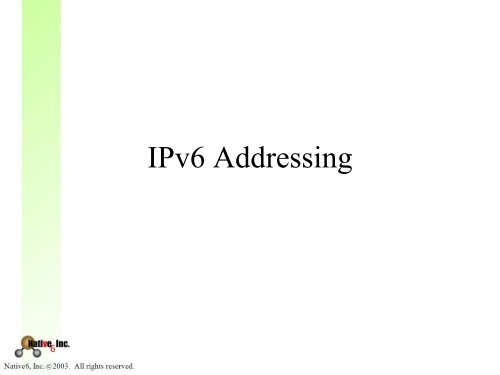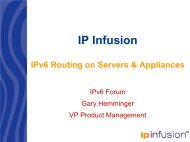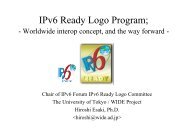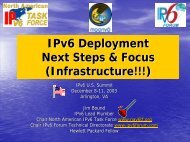IPv6 Addressing
IPv6 Addressing
IPv6 Addressing
You also want an ePaper? Increase the reach of your titles
YUMPU automatically turns print PDFs into web optimized ePapers that Google loves.
<strong>IPv6</strong> <strong>Addressing</strong>• How do we count?• Base 10 numbering system (10 symbols)•0–9• Known as the “decimal” system
<strong>IPv6</strong> <strong>Addressing</strong>• How do computers count? (a.k.a, “bits”)• Base 2 numbering system (2 symbols)•0–1• Known as the “binary” system
<strong>IPv6</strong> <strong>Addressing</strong>• What is hexadecimal?• Base 16 numbering system (16 symbols)•0 –F• A simplified way to represent groups of 4binary “bits”
<strong>IPv6</strong> <strong>Addressing</strong>Counting hexadecimal0123456789ABCDEF101112131415161718191A1B1C1D
<strong>IPv6</strong> <strong>Addressing</strong>• How was it done with IPv4?• 32 bit address• Divided into 4 “octets” (8 bits or a byte)• Each octet ranging from (0-255)11001011 10001110 10000010 00000101203 . 142 . 130 . 5
<strong>IPv6</strong> <strong>Addressing</strong>128-bit addressRepresented inhexadecimalDEC BIN HEX0 0000 01 0001 12 0010 23 0011 34 0100 45 0101 56 0110 67 0111 78 1000 89 1001 910 1010 A11 1011 B12 1100 C13 1101 D14 1110 E15 1111 F
128 bit address<strong>IPv6</strong> <strong>Addressing</strong>0011 1111 1111 1110 1000 0000 1111 00000000 0000 0000 0010 0000 0000 0000 00000000 0000 0000 0000 0000 0000 0001 00000000 0000 0000 0000 0000 0000 0000 0000Represented in Hex (every 4 bits)3FFE:80F0:0002:0000:0000:0010:0000:0000
<strong>IPv6</strong> <strong>Addressing</strong>3FFE:80F0:0002:0000:0000:0010:0000:0000Every 4 hex is separated by a colon “ : ”Every 4 hex represents 16 bits or 2 bytes
<strong>IPv6</strong> <strong>Addressing</strong>3FFE:80F0:0002:0000:0000:0010:0000:00003FFE:80F0:2:0:0:10:0:0• Drop leading zeros within any 16-bit chunk
<strong>IPv6</strong> <strong>Addressing</strong>3FFE:80F0:0002:0000:0000:0010:0000:00003FFE:80F0:2::10:0:0• Represent any contiguous multiple chunks ofzeros into a double colon, but use only once.
<strong>IPv6</strong> <strong>Addressing</strong>3FFE:80F0:0002:0000:0000:0010:0000:00003FFE:80F0:2:0:0:10::• Only allowed once in address
<strong>IPv6</strong> <strong>Addressing</strong>3FFE:0000:0000:0000:0022:0000:0000:00003FFE::22::3FFE::22:0:0:0 or 3FFE:0:0:0:22::• Only allowed once in address or else it becomesambiguous
<strong>IPv6</strong> Prefix2001:CB8E:2A::D15/642001:CB8E:002A:0000:0000:0000:0000:0D150010 0000 0000 0001 1100 1011 1000 1110 0000 0000 0010 1010 0000 0000 0000 00000000 0000 0000 0000 0000 0000 0000 0000 0000 0000 0000 0000 0000 1101 0001 01012001:CB8E:2A::/64 is network
<strong>IPv6</strong> Prefix2002:3F0E:102A::7/482002:3F0E:102A:0000:0000:0000:0000:00070010 0000 0000 0010 0011 1111 0000 1110 0001 0000 0010 1010 0000 0000 0000 00000000 0000 0000 0000 0000 0000 0000 0000 0000 0000 0000 0000 0000 0000 0000 01112002:3F0E:102A::/48 is network
<strong>IPv6</strong> Prefix3FFE:10C2:43EE:D0C:F::C15/1263FFE:10C2:43EE:0D0C:000F:0000:0000:0C150011 1111 1111 1110 0001 0000 1100 0010 0100 0011 1110 1110 0000 1101 0000 11000000 0000 0000 1111 0000 0000 0000 0000 0000 0000 0000 0000 0000 1100 0001 01013FFE:10C2:43EE:D0C:F::C14/126 is network
<strong>IPv6</strong> Prefix2002:3F0E:102A:3010:33::7/75
<strong>IPv6</strong> Prefix2002:3F0E:102A:3010:33::7/752002:3F0E:102A:3010:0033:0000:0000:00070010 0000 0000 0010 0011 1111 0000 1110 0001 0000 0010 1010 0011 0000 0001 00000000 0000 0011 0011 0000 0000 0000 0000 0000 0000 0000 0000 0000 0000 0000 01112002:3F03:102A:3010:20::/75
Types of <strong>IPv6</strong> Addresses•Unicast• Multicast (no broadcast)• Anycast
Unicast Address• A single unique address identifying an <strong>IPv6</strong>interface
Multicast Address• An identifier for a group of interfaces.– Usually belonging to more than one node– Interfaces may belong to more than onemulticast group– Replaces broadcasts– May not be used as a source address
Anycast Address• An <strong>IPv6</strong> address that is assigned to morethan one interface (typically more than onenode).– Same as Unicast addresses– Derived from the same address space– Packets destined for anycast address aredelivered to the “nearest” interface– Subnet router anycast address definition
Anycast examplerouteradvertising192.88.99.0/24Internet BGP Routingrouteradvertising192.88.99.0/24routeradvertising192.88.99.0/24
Other <strong>IPv6</strong> Addresses• The unspecified Address– 0:0:0:0:0:0:0:0 ::• The loopback Address– 0:0:0:0:0:0:0:1 ::1
<strong>IPv6</strong> <strong>Addressing</strong>0000 0000 Unassigned* 011 Unassigned0000 0001 Unassigned 100 Unassigned0000 001 NSAP 101 Unassigned0000 01 Unassigned 110 Unassigned0000 1 Unassigned 1110 Unassigned0001 Unassigned 1111 0 Unassigned001 Aggregatable 1111 10 Unassigned010 Unassigned 1111 110 Unassigned1111 1110 0 Unassigned* Some reserved addresses are from this space
<strong>IPv6</strong> <strong>Addressing</strong>1111 1110 10 Link-Local-Use FE801111 1110 11 Site-Local-Use FEC0*1111 1111 Multicast FF—* Being deprecated
<strong>IPv6</strong> <strong>Addressing</strong>• Unicast <strong>Addressing</strong>– ISPs assign these addresses to organizations– Offers globally-unique addresses
<strong>IPv6</strong> <strong>Addressing</strong>• Site-Local-Use Addresses*– Assigned to interfaces within an isolatedintranet– Can easily be migrated to provider-basedaddresses– Much like private addressing in IPv4 (i.e.10.0.0.0 network)*Being deprecated
<strong>IPv6</strong> <strong>Addressing</strong>• Link-Local-Use Addresses– All <strong>IPv6</strong> interfaces have a link-local address– Used to reach neighboring nodes attached tosame link– Self-configured by interface– Router will not forward packets with Link-Local source or destination
<strong>IPv6</strong> <strong>Addressing</strong>• Link-Local-Use Addresses– Usually formed by pre-pending the “wellknown” Link-Local prefix FE80::0 to theInterface Identifier– Can be statically assigned or created through apseudo random process
<strong>IPv6</strong> <strong>Addressing</strong>• Interface Identifier– Always 64 bits (least significant)– Can be “randomly” generated – RFC 3041– Ethernet uses MAC (or EUI-64)
<strong>IPv6</strong> <strong>Addressing</strong>• What is EUI-64– Extended Unique Identifier. Replaces MACaddresses– 24-bit company_id (tracked by IEEE)– 40-bit “unique” identifier
<strong>IPv6</strong> <strong>Addressing</strong>• What is MAC and how does it work w/ EUI– Media Access Control. 48 bits– 24-bit company_id (tracked by IEEE)– 24-bit “unique” identifier– Mapped into EUI-64 for creation of anInterface Identifier
<strong>IPv6</strong> <strong>Addressing</strong>• How is MAC converted to EUI– Example MAC CC-CC-CC-UU-UU-UU• CC = Company identifier• UU = Unique identifier– Insert FF-FE between CC and UU– CC CC CC FF FE UU UU UU
<strong>IPv6</strong> <strong>Addressing</strong>• Example MAC-to-EUI conversion– MAC = 00-D0-59-0C-61-F3– EUI = 00-D0-59-FF-FE-0C-61-F3
<strong>IPv6</strong> <strong>Addressing</strong>• The <strong>IPv6</strong> interface identifier is formed bycomplimenting the “Universal/Local” bit inan EUI-64 address– EUI = 00-D0-59-0C-61-F3– 0000 0000 1101 0000 0101 1001 0000 1100 0110 0001 1111 0011– <strong>IPv6</strong> identifier = 02-D0-59-FF-FE-0C-61-F3
<strong>IPv6</strong> <strong>Addressing</strong> continuedMulticast
<strong>IPv6</strong> Multicast AssignmentsNode-Local Scope1111 1111 0000 0001FF01:0:0:0:0:0:0:1FF01:0:0:0:0:0:0:2All Nodes AddressAll Routers Address
<strong>IPv6</strong> Multicast AssignmentsLink-Local ScopeFF02:0:0:0:0:0:0:1FF02:0:0:0:0:0:0:2FF02:0:0:0:0:0:0:3FF02:0:0:0:0:0:0:4FF02:0:0:0:0:0:0:5FF02:0:0:0:0:0:0:6FF02:0:0:0:0:0:0:7FF02:0:0:0:0:0:0:8All Nodes AddressAll Routers AddressUnassignedDVMRP RoutersOSPFIGPOSPFIGP DRST RoutersST Hosts
<strong>IPv6</strong> Multicast AssignmentsLink-Local Scope - continuedFF02:0:0:0:0:0:0:9FF02:0:0:0:0:0:0:AFF02:0:0:0:0:0:0:BFF02:0:0:0:0:0:0:DFF02:0:0:0:0:0:0:EFF02:0:0:0:0:0:1:1FF02:0:0:0:0:0:1:2FF02:0:0:0:0:0:FFXX:XXXXRIP RoutersEIGRP RoutersMobile-AgentsAll PIM RoutersRSVP encapsulationLink NameAll-dhcp-agentsSolicited node
<strong>IPv6</strong> Multicast AssignmentsSite-Local ScopeFF05:0:0:0:0:0:0:2FF05:0:0:0:0:0:0:3FF05:0:0:0:0:0:0:4FF05:0:0:0:0:0:0:1000FF05:0:0:0:0:0:0:13FFAll Routers AddressAll DHCP ServersAll DHCP RelaysService Location
All Scope<strong>IPv6</strong> Multicast AssignmentsFF0X:0:0:0:0:0:0:101 NTP ServerFF0X:0:0:0:0:0:0:102 SGI-DogfightFF0X:0:0:0:0:0:0:103 Rwhod
<strong>IPv6</strong> Multicast Assignments• Scope Level– FF01 – Node Local– FF02 – Link Local– FF05 – Site Local
<strong>IPv6</strong> TLA structure
Aggregatable Global UnicastFPTLA ID RES NLA ID SLA IDInterface Identifier• FP – 3 bits – Format Prefix (001)• TLA – 13 bits – Top Level Aggregator (8192)• RES – 8 bits – Reserved• NLA – 24 bits – Next Level Aggregator• SLA – 16 bits – Site Level Aggregator• Interface Identifier – 64 bits• RFC 2373
Aggregatable Global UnicastFPTLA ID Sub-TLA NLA ID SLA IDInterface Identifier• FP – 3 bits – Format Prefix (001)• TLA – 13 bits – Top Level Aggregator (8192)• Sub-TLA - 13 bits - Sub-Top Level Aggregator• NLA ID - 19 bits - Next Level Aggregator• SLA – 16 bits – Site Level Aggregator• Interface Identifier – 64 bits• RFC 2928






